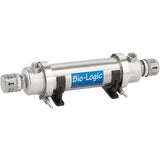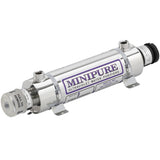UV Germicidal Water Disinfection Effective Against Some Pathogens Not Killed By Chlorination
Posted by Dave on for ProLampSales

Should water used by the public be disinfected with chlorine or ultraviolet germicidal light?
This post looks at the pros and cons for each approach.
Whether it’s water used in food processing or water that comes out of a faucet for drinking or water in a municipal swimming pool, elimination of harmful bacteria and other pathogens is a principal safety concern both for government and business entities as well as the general public.
For years city and municipal water systems have used chlorine as the preferred method of water disinfection. Chlorine is added to public water systems as compressed gas as well as other liquid and solid formulations. While high amounts of chlorine can be harmful, the dispersion of the chlorine in a water system is such that the mix results in high enough levels to kill bacteria but small enough levels to make for safe drinking.
Chlorination is very effective in killing most bacteria of concern, but it has some drawbacks.
First, it leaves an odor. While not generally a problem for municipal water supplies, anyone who has spent time in a public swimming pool or a backyard hot tub will be familiar with this odor.
Second, there are known chlorine resistant pathogens including viruses, parasites and even some bacteria. Some advancements have been made recently to improve the efficacy of water chlorination to address these issues.
An alternative approach to water disinfection is ultraviolet (UV) light. UV disinfection has been around a long time, but in recent years it has grown in use primarily because it addresses the principal weakness of chlorine treatment - resistant pathogens.
There is no known virus or bacteria that is immune to (UV) ultraviolet light.
Ultraviolet radiation (UV) destroys all the RNA & DNA of any bacteria, virus and all microscopic organisms present in the water. This essentially renders the organisms unable to reproduce future generations, thus killing them off.
UV germicidal light sources can kill a massive number of micro-organisms in the water and is about 99.99% effective against most germs, like the E-coli.
Ultraviolet germicidal lamps usually produce energy at about 253.7 nanometers. The lamps that are used for purification of water also emit-radiation at about 185 nanometers for ozone-production. These wavelengths are not visible to the naked human eye, though germicidal lamps can also emit visible light.
The EPA has started advising municipal water-suppliers to treat all water with ultraviolet radiation so as to inactivate key-pathogens like the adenovirus and various other microorganisms more resistant to chlorine.
Almost all the bottled water that is sold in the developed-world goes through an ultraviolet water treatment system before bottling.
Aside from drinking water, other water disinfection needs have been met with UV for some time. Water used in food processing is one example. Public and residential ponds often use UV systems incorporated in the pond equipment to prevent algae and other harmful microorganisms from building up and negatively impacting the health of fish and other plants.
With high public awareness and concern over environmental pathogens, UV germicidal applications for water systems of all types will only grow.
Caution: UV is harmful to skin and eyes. When working with any ultraviolet light source exercise extreme caution to minimize exposure.
- Posted in Ultraviolet Light
Featured Products (View All)
0 Comments




